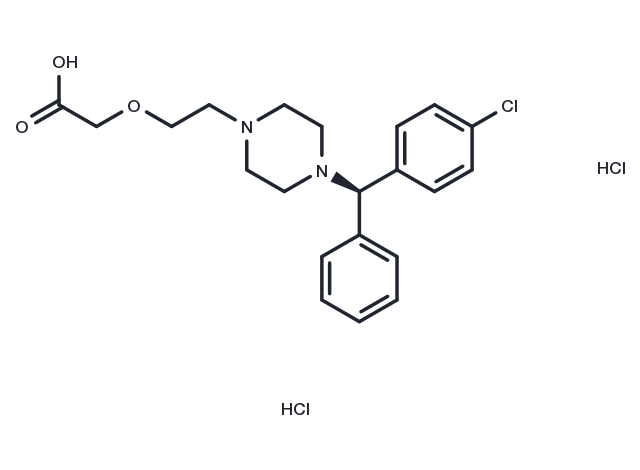Powder: -20°C for 3 years | In solvent: -80°C for 1 year


Levocetirizine Dihydrochloride (Xyzal Dihydrochloride) is a third-generation peripheral H1-receptor antagonist. Acting as an antihistaminic agent, it specifically targets the histamine H1-receptor. Levocetirizine Dihydrochloride is the R-enantiomer of Cetirizine, which gives it a higher affinity for the H1-receptor than the S-enantiomer. Due to this enhanced affinity, Levocetirizine Dihydrochloride is effective in treating allergic rhinitis and chronic idiopathic urticaria.

| Pack Size | Availability | Price/USD | Quantity |
|---|---|---|---|
| 10 mg | In stock | $ 43.00 | |
| 25 mg | In stock | $ 78.00 | |
| 50 mg | In stock | $ 133.00 | |
| 100 mg | In stock | $ 198.00 | |
| 200 mg | In stock | $ 297.00 | |
| 500 mg | In stock | $ 513.00 | |
| 1 g | In stock | $ 729.00 | |
| 1 mL * 10 mM (in DMSO) | In stock | $ 48.00 |

| Description | Levocetirizine Dihydrochloride (Xyzal Dihydrochloride) is a third-generation peripheral H1-receptor antagonist. Acting as an antihistaminic agent, it specifically targets the histamine H1-receptor. Levocetirizine Dihydrochloride is the R-enantiomer of Cetirizine, which gives it a higher affinity for the H1-receptor than the S-enantiomer. Due to this enhanced affinity, Levocetirizine Dihydrochloride is effective in treating allergic rhinitis and chronic idiopathic urticaria. |
| In vivo | Levocetirizine (0.4 mg/kg; oral administration; male Sprague-Dawley rats) treatment shows that the Cmax, AUC0-t, AUC0-∞ and t1/2 are 0.34 μg/mL, 3.26 μg h/mL, 3.67 μg h/mL and 2.34 hours, respectively in Sprague-Dawley rats[1]. |
| Synonyms | Xyzal Dihydrochloride, (-)-Cetirizine Dihydrochloride |
| Molecular Weight | 461.81 |
| Formula | C21H27Cl3N2O3 |
| CAS No. | 130018-87-0 |
Powder: -20°C for 3 years | In solvent: -80°C for 1 year
H2O: 90 mg/mL (194.9 mM), Sonication is recommended.
DMSO: 90 mg/mL (194.9 mM), Sonication is recommended.
You can also refer to dose conversion for different animals. More
bottom
Please see Inhibitor Handling Instructions for more frequently ask questions. Topics include: how to prepare stock solutions, how to store products, and cautions on cell-based assays & animal experiments, etc.
Levocetirizine Dihydrochloride 130018-87-0 GPCR/G Protein Immunology/Inflammation Neuroscience Histamine Receptor Cetirizine Dihydrochloride Cetirizine Levocetirizine Xyzal Dihydrochloride (-)-Cetirizine Dihydrochloride Xyzal inhibitor inhibit
